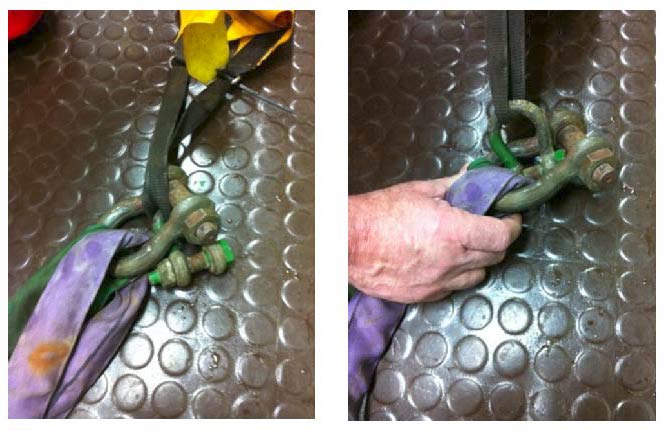Uncontrolled ascent of lift bag
A member has reported an incident in which an inflated underwater lift bag was let go, causing it to rise to the surface in an uncontrolled way. The incident occurred when a diver was working on the seabed and engaged in rigging a 100kg lift bag, which was to be used to assist in handling and positioning a load. The lift bag was rigged with a small shackle through its strops. The load was rigged with a large shackle attached to the lift strops and a holdback.
When connecting the two however the diver, instead of joining the two shackles together, simply passed the lift bag strops through the larger shackle (see illustration below). When the rigging was complete, the diver untied the inverter line and asked the dive supervisor for pneumo gas to be supplied, so he could put a small amount of gas into the lift bag, to cause it to stand up, and check the overall arrangement.

As the diver proceeded to tie the inverter line to a standoff, the gas in the lift bag caused it to ascend with just enough buoyancy to lift the lift bag rigging and small shackle through the larger shackle. Although by no means fully inflated the lift bag then ascended to surface.
There were no injuries or damage to equipment. The location of the lift bag, strops, associated rigging, and positioning of the divers did not pose a risk to either from snagging of umbilicals or hands being trapped or entangled around any part of the strops or rigging. There was insufficient buoyancy in the bag to lift either diver from working depth.
An investigation revealed the following:
- The immediate cause was that the diver, though competent for the task in hand, made a mistake during the rigging up of the lift bag;
- Underlying causes associated with the incident were considered to be:
- risk assessment for the various parts of this task was not adequate nor fully applied
- written instructions for internal use were not entirely clear or in sufficient detail (although an admittedly obvious precaution, neither IMCA D 016 –Guidance on open parachute type underwater air lift bags– nor the company procedure for the use of lift bags based on this guidance, included a step specifically stating that holdback and inverter lines should be attached before any gas is introduced)
- monitoring – checks and inspections of workplace precautions and risk control methods were not adequate.
The following corrective and preventative actions were made:
- Vessel ‘safety focus’ on checking/rechecking progress with activities/tasks;
- Revision of in-house procedures for use of lift bags, to include specifics on checking lines/rigging before inflation;
- IMCA was advised of the incident and a proposal was put forward for revision of IMCA D 016;
- Appropriate pre-job briefings were enhanced (where there is a use of lift bags) to ensure safety requirements and lessons learnt from the incident are communicated and applied as part of ongoing raising of awareness;
- Details and video footage of the incident circulated to others in industry for assistance with future training courses;
- Encouraging younger divers and supervisors to attend training courses on subsea lifting and rigging (including lift bags);
- Post saturation debriefs held with dive teams including details of the incident, review of video footage and sharing key lessons learnt.
The following lessons were drawn from the incident:
- The importance of ensuring adherence to task risk assessments so control measures identified are applied stringently;
- Checks and re-checks as per safe working procedure and standard practice should be enforced by workers and supervisors to ensure that risk control measures are implemented and maintained.
Safety Event
Published: 8 June 2012
Download: IMCA SF 05/12
IMCA Safety Flashes
Submit a Report
IMCA Safety Flashes summarise key safety matters and incidents, allowing lessons to be more easily learnt for the benefit of all. The effectiveness of the IMCA Safety Flash system depends on Members sharing information and so avoiding repeat incidents. Please consider adding [email protected] to your internal distribution list for safety alerts or manually submitting information on incidents you consider may be relevant. All information is anonymised or sanitised, as appropriate.
IMCA’s store terms and conditions (https://www.imca-int.com/legal-notices/terms/) apply to all downloads from IMCA’s website, including this document.
IMCA makes every effort to ensure the accuracy and reliability of the data contained in the documents it publishes, but IMCA shall not be liable for any guidance and/or recommendation and/or statement herein contained. The information contained in this document does not fulfil or replace any individual’s or Member's legal, regulatory or other duties or obligations in respect of their operations. Individuals and Members remain solely responsible for the safe, lawful and proper conduct of their operations.
